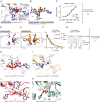ENPP1's regulation of extracellular cGAMP is a ubiquitous mechanism of attenuating STING signaling
- PMID: 35588451
- PMCID: PMC9173814
- DOI: 10.1073/pnas.2119189119
ENPP1's regulation of extracellular cGAMP is a ubiquitous mechanism of attenuating STING signaling
Abstract
The metazoan innate immune second messenger 2′3′-cGAMP is present both inside and outside cells. However, only extracellular cGAMP can be negatively regulated by the extracellular hydrolase ENPP1. Here, we determine whether ENPP1’s regulation of extracellular cGAMP is a ubiquitous mechanism of attenuating stimulator of interferon genes (STING) signaling. We identified ENPP1H362A, a point mutation that cannot degrade the 2′-5′ linkage in cGAMP while maintaining otherwise normal function. The selectivity of this histidine is conserved down to bacterial nucleotide pyrophosphatase/phosphodiesterase (NPP), allowing structural analysis and suggesting an unexplored ancient history of 2′-5′ cyclic dinucleotides. Enpp1H362A mice demonstrated that extracellular cGAMP is not responsible for the devastating phenotype in ENPP1-null humans and mice but is responsible for antiviral immunity and systemic inflammation. Our data define extracellular cGAMP as a pivotal STING activator, identify an evolutionarily critical role for ENPP1 in regulating inflammation, and suggest a therapeutic strategy for viral and inflammatory conditions by manipulating ENPP1 activity.
Keywords: ENPP1; STING; cGAMP; extracellular cGAMP; immunotransmitter.
Conflict of interest statement
Competing interest statement: L.L. is a scientific cofounder of Angarus Therapeutics, which has exclusive licensing rights to the patent WO2020160333A1. J.A.C., V.B., and L.L. are inventors on the patent WO2020160333A1.
Figures






References
Publication types
MeSH terms
Substances
Grants and funding
LinkOut - more resources
Full Text Sources
Molecular Biology Databases
Research Materials
Miscellaneous

